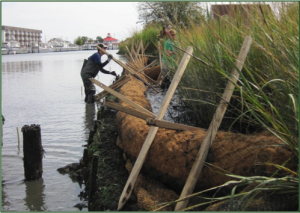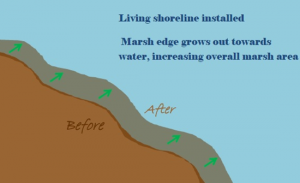
Facebook Twitter Instagram YouTube RSS Feed
Written on: March 15th, 2017 in Living Shorelines
Living Shorelines Really Do Work!

PDE and DNREC work together to install a living shoreline along the eroding marsh edge next to the ball field in Lewes in 2014.
Tidal wetlands are incredible ecosystems that protect us and our properties from storm floods, provide habitat for fish and wildlife, clean our water, and store carbon from the atmosphere. When these wetlands are in good condition, they have the ability to keep up with sea level rise, allowing them to persist as water levels increase. Unfortunately, many tidal wetlands are in danger of disappearing because they are stressed, leaving them vulnerable to erosion and sea level rise. The good news is that scientists are developing new ways to prevent that from happening.
Traditionally, “hardened” or “gray” shorelines, such as breakwaters, bulkheads, and riprap, have been built upon stretches of shoreline to protect properties from wave energy and flooding. Hardened shorelines, however, can actually harm our coastlines. Waves bounce off of these hardened structures and reflect back out toward the water causing that wave’s energy to go to another location where it can still do damage. They also disconnect tidal marsh habitat from the water, which prevents wildlife from moving between the water and the marsh.
That’s where living shorelines come in; living shorelines are considered “softer” or “greener” shoreline protection methods because they incorporate natural materials, such as coir logs and oyster shell bags. They can benefit the wetland ecosystem and maintain the connection between the water and the marsh, while still providing protection to upland areas and preventing erosion of the shoreline.
Data that was recently collected from a living shoreline in Lewes, DE shows us just how effective living shorelines can be!

Analysis of data from a living shoreline in Lewes showed that the installation significantly extended the marsh edge towards the water. Increasing the marsh area can help stabilize eroding shorelines and help them face rising sea levels.
It was found that the Lewes living shoreline allowed the marsh edge to extend further out towards the water than it did before the installation. The project also significantly increased the height of the marsh, allowing it to support growth of smooth cordgrass (Spartina alterniflora) where it could not previously. The coir-fiber materials and shell bags that were used to construct the living shoreline did not degrade, showing that they are durable materials that can successfully be used in living shorelines projects.

Smooth cordgrass can only grow in the marsh at a certain height above water or else it might drown. The Lewes living shoreline created a higher elevation that supported growth of smooth cordgrass.
So, what do all of these results from the Lewes living shoreline project mean? The results show us that living shorelines really are effective at increasing the stability and ecological character of marsh edges in the face of erosion and sea level rise.
This means that they can be extremely helpful for protecting us and our properties against flooding and coastal storms, while also creating habitat for plants and wildlife! This is encouraging news that can help scientists, managers, and landowners further plan to protect our shorelines in ways that are both effective and more environmentally friendly than traditional hardened shorelines.
This project was a collaboration between our program (DNREC, Wetland Monitoring & Assessment) and the Partnership for the Delaware Estuary (PDE). To learn more about the Lewes project visit our previous blog post. Or you can dig into the data by clicking here for the full detailed report of results from the study.